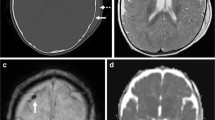Abstract
This article highlights five important aspects of the clinical problem of evaluating young children who are suspected of having abusive head trauma: 1) the clinical questions to be addressed, 2) challenges when evaluating young children with suspected abuse, 3) key aspects of clinical practice and data collection, 4) a framework for decision-making and 5) key articles in the literature that can help inform a sound clinical decision about the likelihood of abuse.

Similar content being viewed by others
References
Jenny C (ed) (2011) Child abuse & neglect: diagnosis, treatment, and evidence. Saunders, St. Louis
Adams LR, Duhaime C, Jenny C et al (2009) Head trauma. In: Reece R, Christian CW (eds) Child abuse: medical diagnosis and management, 3rd edn. American Academy of Pediatrics, Elk Grove, pp 53–120
Christian CW, Block B (2009) Committee on child abuse and neglect. Abusive head trauma in infants and children. Pediatrics 123:1409–1411
Leventhal JM (2000) Thinking clearly about evaluations of suspected child abuse. Clin Child Psychol Psychiatry 5:139–147
Hooft A, Ronda J, Schaeffer P et al (2013) Identification of physical abuse cases in hospitalized children: accuracy of international classification of disease codes. J Pediatr 162:80–85
Jenny C, Hymel KP, Ritzen A et al (1999) Analysis of missed cases of abusive head trauma. JAMA 281:621–626
Sheets LK, Leach ME, Koszewski IJ et al (2013) Sentinel injuries in infants evaluated for child physical abuse. Pediatrics 131:701–707
Pierce MC, Kaczor K, Aldridge S et al (2010) Bruising characteristics discriminating child abuse from accidental trauma. Pediatrics 125:67–74
Adamsbaum C, Grabar S, Mejean N et al (2010) Abusive head trauma: judicial admissions highlight violent and repetitive shaking. Pediatrics 126:546–555
Starling SP, Patel S, Burk BL et al (2004) Analysis of perpetrator admissions to inflicted traumatic brain injury in children. Arch Pediatr Adolesc Med 158:454–458
Biron DL, Shelton D (2005) Perpetrator accounts in infant abusive head trauma brought about by a shaking event. Child Abuse Negl 29:1347–1358
Bechtel K, Stoessel K, Leventhal JM et al (2004) Characteristics that distinguish accidental from inflicted injury in hospitalized young children with head trauma. Pediatrics 114:165–168
Buys YM, Levin AV, Enzenauer RW et al (1992) Retinal findings after head trauma in infants and young children. Ophthalmology 99:1718–1723
Trenchs V, Curoy AI, Morales M et al (2008) Retinal hemorrhages in head trauma resulting from falls: differential diagnosis with non-accidental trauma in children younger than 2 years of age. Childs Nerv Syst 24:815–820
Forbes BJ, Cox M, Christian CV (2008) Retinal hemorrhages in patients with epidural hematomas. JAAPOS 12:177–180
Vinchon M, de Foort-Dhellemmes S, Desurmont M et al (2010) Confessed abuse versus witnessed accidents in infants: comparison of clinical, radiological, and ophthalmological data in corroborated cases. Childs Nerv Syst 26:637–645
Maguire SA, Kemp AM, Lumb RC et al (2011) Estimating the probability of abusive head trauma: a pooled analysis. Pediatrics 128:550–564
Levin AV (2010) Retinal hemorrhages in abusive head trauma. Pediatrics 126:961–970
Conflicts of interest
Dr. Leventhal is the PI on grants to Yale University that support the Child Abuse Programs and Child Abuse Prevention Programs. He is on the International Advisory Board of the National Center on Shaken Baby Syndrome. Drs. Leventhal, Asnes, Pavlovic and Moles testify in court regarding child abuse cases
Author information
Authors and Affiliations
Corresponding author
Rights and permissions
About this article
Cite this article
Leventhal, J.M., Asnes, A.G., Pavlovic, L. et al. Diagnosing abusive head trauma: the challenges faced by clinicians. Pediatr Radiol 44 (Suppl 4), 537–542 (2014). https://doi.org/10.1007/s00247-014-3074-1
Received:
Accepted:
Published:
Issue Date:
DOI: https://doi.org/10.1007/s00247-014-3074-1



